Cornering Less Control
Questions to gain a competitive edge beyond the corner we control.
In 2025, much in the world that affects doing business is out of our control. Trade tensions, shifting capital flows, supply shocks, new technologies, and demographic shifts move faster than we can manage. The instinct is to shrink back into our corner, where costs, teams, or operations feel controllable.
Yet if we stay in our corner, we miss the bigger picture. And often, that is where the real opportunities lie.
We can step out of the corner - even just for an hour - by asking questions that zoom us out, shift our view, and reframe what we can control.
Let’s do that now.
What’s the Point?
Georges Seurat’s A Sunday Afternoon on the Island of La Grande Jatte is painted using pointillism. Up close, the work is made of thousands of separate dots, in reds, blues, greens, and yellows, that appear scattered and disconnected. Viewed from a distance, those dots merge into a complete scene: Parisians by the river, trees casting shade, and boats on the water.
A Sunday on La Grande Jatte, Georges Seurat (1884–1886). Source: Google Arts & Culture, https://artsandculture.google.com/asset/a-sunday-on-la-grande-jatte/twGyqq52R-lYpA?hl=en
It’s the same in business. Leaders often zoom into one corner of the canvas - the part of the business or the world that they know best, the part they feel they can control. Costs, teams, or immediate operations. From that vantage point, the picture looks familiar yet incomplete. Step back, and the fuller view emerges: risks, opportunities, and flows that only make sense in context.
A Factful View
Hans Rosling’s book Factfulness and the Gapminder Foundation take a similar stance. Their mission is to fight ignorance with a fact-based worldview. Notwithstanding the very real climate, humanitarian, and conflict challenges facing the world in 2025, they show how our default perception of the world is systematically too negative. For example, most people:
Overestimate global poverty rates, when extreme poverty has actually declined dramatically in the past 30 years.
Underestimate improvements in health and education, such as child mortality halving in many regions.
Pay attention to crises - natural disasters, conflicts, downturns - while rarely hearing about steady progress.
The danger is not in overlooking global crises, yet in allowing them to dominate our attention that we miss the parallel story of steady progress and the opportunities it opens for business.
As Rosling wrote: “Factfulness is recognising when we get negative news, and remembering that information about bad events is much more likely to reach us. When things are getting better, we often don’t hear about them.”
Screenshot from Gapminder Foundation website (https://www.gapminder.org/), captured August 2025.
In business, the same bias applies. When external conditions contract and uncertainty rises, leaders tend to double down on their corner of control. That instinct offers stability, yet it also risks narrowing perspective, reinforcing bias, and missing bigger opportunities.
The Illusion of Control
Psychologists call this the Illusion of Control - the belief that we can influence outcomes that are mostly outside our grasp. In business, this means focusing heavily on levers that feel manageable - internal costs, team processes, immediate KPIs - while overlooking external shifts that carry greater risk and potentially even greater upside.
The Cost of Staying in the Corner
Two related theories explain why this happens:
Attentional bias makes us focus on emotionally charged signal, such as negative news, or urgent issues, while ignoring weak signals of progress or opportunity.
Cognitive control directs our attention under uncertainty. Leaders gravitate to what feels manageable: near-term numbers, controllable processes, tangible fixes.
The upside is stability. The downside is organisational myopia and resistance to important global shifts and opportunities.
Important Points
Today’s most transformative trends, technologies, threats, and opportunities often originate beyond our familiar local context, shaped by global innovation hubs and transnational forces:
Global Origins of Innovation
Startup and Technology Hotspots: Groundbreaking innovations are emerging from global cities far beyond any single nation's borders. In 2025, hubs like San Francisco, Beijing, Berlin, Bangalore, and Tel Aviv lead the world in AI, fintech, biotechnology, cybersecurity, and green technologies. Their rapid advances, and the impact of their startups, shape industries and redefine possibilities worldwide.
New Disruptors: The rise of cities like Madrid and Recife as leading innovation and entrepreneurial centers illustrates that major technological leaps can originate anywhere, rapidly scaling and influencing far-flung markets.
Globalisation of Threats and Opportunities
Technology Trends: Tech breakthroughs, such as AI, quantum computing, and green energy, are highly globalised and often driven by competition between countries, making their adoption and impact international regardless of origin. McKinsey’s trends for 2025 highlight “regional and national competition,” meaning the next AI or bioengineering advance, for better or worse, might emerge from anywhere and influence every corner of the globe.
Economic and Regulatory Shifts: New regulations, market disruptions, and supply chain changes increasingly stem from cross-border interactions and global pressure, rather than local policies alone. Significant threats, such as cyber attacks, climate risk, or pandemic-related economic shocks, frequently arise from outside one’s immediate region and ripple outward.
Business and Societal Implications
Strategic Alignment: For organisations and leaders, success now hinges on monitoring global domains, building international partnerships, and adapting nimbly when distant trends or threats reach local environments.
Inclusive Innovation: Global technology reports urge organisations and governments to recognise and shape innovation with an international, collaborative perspective, lest opportunity or risk bypass them entirely.
The consensus among technology analysts and innovation reports is that the epicenter of transformative change is less about proximity and far more about global interconnectedness, requiring everyone to look beyond their immediate surroundings for the signals that will shape our collective future.
Questions to Zoom Out
It can be frustrating to see the bigger picture alone, especially when colleagues or senior executives insist on staying in the known, familiar corner.
To counter the illusion of control, structured questions enable a wider view. These questions help us step beyond our corner, scan the whole canvas, and decide what deserves focus for action:
External, Strategic, Action-Oriented
What external trends (technological, societal, economic, regulatory, environmental) could disrupt or accelerate us in the next 1–3 years - and how are we preparing?
Could a competitor, new entrant, or substitute fundamentally alter our sector -and are we ready for radical, not just incremental, shifts?
Which of our assumptions about markets, customers, or stakeholders might be outdated - and what evidence would challenge them?
Who outside our organisation sees signals we are missing? What can we learn from adjacent industries or regions?
If we ran a PESTLE or SWOT today, what high-impact, low-probability risks or opportunities deserve our creative attention?
Group Reflection
How do we bring dissenting voices and cognitive friction into strategy conversations?
What leading indicators, not just outcomes, signal change in our environment?
If an external shock hit tomorrow, which projects or priorities would we stop, and which would we double down on?
Pointed Leadership
In uncertain times, narrowing our gaze to the corner we control feels natural. Yet like Seurat’s dots, the bigger picture only emerges when we step back.
The challenge is to resist the illusion of control, zoom out, and then decide deliberately which part of the picture to bring back into focus.
When we see the bigger picture, we can play a bigger game.
The bigger game starts where control ends.




